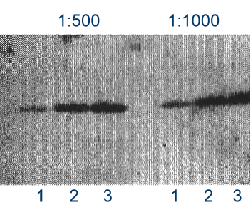BACE-1
Cleavage of amyloid precursor protein (APP) into 40 or 42 amino acid amyloid β (aβ) peptides is a result of the action of two proteases β- and γ-secretase. The beta-site APP cleaving enzyme, or BACE-1, is a transmembrane aspartic protease that is localized in the golgi and endosomes. Low levels of BACE-1 mRNA are found in most adult tissues with a higher level of expression in pancreas.

Image: Detection of BACE-1 in human cerebellum. Stained with HRP-DAP (brown) and counter-stained with hemtoxylin (blue).
Abeta 40 (beta amyloid 1-40) and Abeta 42 (beta amyloid 1-42)
Amyloid beta-protein (Abeta) is associated with neuronal injury and death in Alzheimer's disease. These proteins are the main components of amyloid plaques. Abeta 42 plays a bigger role in deneurogeneration and is more strongly associated with Alzheimer's disease than Abeta 40.

Image: Detection of Abeta 40 on 5 ng of peptide per lane using NB 300-225. Lane 1: Abeta-40, lane 2: Abeta-42, lane 3: Abeta-40 and -42 mix




No comments:
Post a Comment